
|   |

|   |
A peek into Kathak's history at the Vimal Bhaskar National Awards - Kiran Java email: kiran@kiranjava.com June 15, 2022 On June 5th, the fourth edition of the Vimal Bhaskar National Awards to celebrate service to the performing arts was hosted by the Nandkishore Cultural Society at Jawaharlal Nehru Auditorium, Pune. The award was bestowed upon Dr. Puru Dadheech and Dr. Vibha Dadheech for their relentless service to Kathak classical dance. Dr. Puru Dadheech presented a lecture-demonstration titled 'Kathak through the lens of medieval treatises'. Prior to the awards, on the 3rd and 4th of June, Dr. Puru Dadheech and Dr. Vibha Dadheech led Kathak workshops for dancers in Pune. 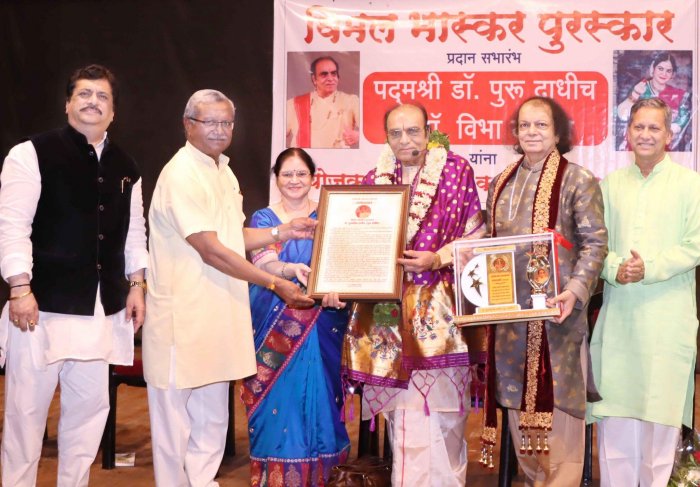 Dr. Puru Dadheech and Dr. Vibha Dadheech were felicitated with the Vimal Bhaskar National Award, Pune. Photo: Sushil Rathod The Vimal Bhaskar Awards have previously been bestowed upon Late Kathak queen Sitara Devi, Late Pt. Birju Maharaj, Saswati Sen, Pt. Ramlal Bareth and Mathuradevi Bareth. Dr. Nandkishore Kapote said, "When I expressed an interest in dancing in the early 70s, society effectively discouraged a male child from doing so. Vimal Kapote, my mother, was the one who encouraged and supported me in pursuing my passion. And then my father, Bhaskar Kapote, supported her decision." By the late 70's Dr. Kapote received a national scholarship to learn Kathak from Pt. Birju Maharaj at Kathak Kendra, Delhi, and later he went on to become the recipient of the Maharashtra State Cultural Award 2004 as well as Maharashtra State Dr. Babasaheb Ambedkar Dalit Mitra Award 2010. When his mother passed away Dr. Kapote instated an award in her name. Dr. Puru Dadheech and Dr. Vibha Dadheech expressed their gratitude for being honored by the Vimal Bhaskar Awards. Speaking on the occasion of the awards, Dr. Puru Dadheech, made an appeal to the Maharashtra State Government to establish a National Award for the Performing Arts. After the award ceremony, Dr. Puru Dadheech delivered a lecture based on his research conducted under the aegis of the Tagore National Fellowship of the Ministry of Culture, Govt. of India. Dr. Sunil Sunkara, Dr. Piyush Raj, and Harshita Sharma Dadheech assisted with the demonstrations. 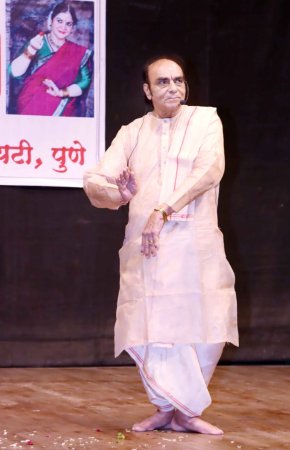 Dr. Puru Dadheech performing 'Shiv Stuti' in Kathak Photo: Sushil Rathod As part of his research, Dr. Puru Dadeech studied over 25 dance manuscripts belonging to a period between 1100 AD to 1900 AD, written in many languages including Sanskrit, Braj Bhasha, Kannada, Tamil, Gujarati and Urdu. Throughout his discussion, Dr. Puru Dadheech presented intriguing details of Kathak's past that astonished the audience. He began with a brief overview of the pre-medieval period and clarified that there are very few dance manuscripts available from the pre-medieval period (prior to 1100 AD). There is the 8th-century Brihaddeshi of Matang Muni wherein the Bharatiya Sangeet has been divided into Margi and Desi. Dr. Dadheech mentioned that Pt. V.N. Bhatkhande has stated in his Shreemal Lakshya Sangeetam text that Margi was established by the earliest divine seers such as Bharata and others. It exists in its purest form but we can no longer see it; we only hear about it. Desi on the other hand is music and dance from various regions developed by the people, for the people in order to bring joy and happiness. Dr. Dadheech mentioned that all that is practiced today is Desi. The canons (rules and regulations) that define the parameters of Desi classical music and dance can be found in medieval age texts. Dr. Dadheech has focused his research on these texts for this reason. A gradual shift from Nritta - pure dance movements to Nritya (dance communicating meaning) in the medieval age According to Dr. Puru Dadheech, dance achieved its pinnacle during this medieval period. He explains that pre-medieval texts state that Bharata received the knowledge of dramaturgy from Lord Brahma and learned pure dance movements bereft of meaning from Tandu muni on the instruction of Lord Shiva. Lord Shiva's Tandav and Parvati's Sukumara (softer movements) were both Nritta or pure dance movements that brought joy without requiring any meanings to be communicated. Dr. Dadheech claims that Bharata did attempt to combine Natya and Nritta at some point but it remained in a state of theory and experimentation for a number of centuries. Only later did the art of Nritya become praxis, or an approved form of practice. In fact, the word Nritya appears for the first time in Amar Singh's Amar Kosh text. Women began to perform Nritya and as a result, Nritya became associated with Lasya dance. Nritya is performed by a solo dancer While Lord Shiva's Nritta was a choreography performed by several dancers at the Purvarang, Nritya came to mean a solo dance. The performer (Narthaki) needs to be an expert at expressing meaning through dance. Nritya, according to Dr. Dadheech, then progressed to the point where it was performed everywhere and hence became well established. A new dance term 'Mukhchaali' was discovered in the medieval dance texts Because of its popularity, a number of dance treatises were written by scholars during this time period keeping in mind Nritya performed by a female solo dancer. According to Dr. Dadheech most of the manuscripts from this time period have coined a new name for this dance called 'Mukhchaali'. He said that Mukh denoted the elements of the Purvarang of Natyashastra and Chaali was a reference to those foot movements that follow the Purvarang's style. Dr. Dadheech emphasizes that by this time, the Purvarang's many elements had begun to decrease. These, he claims, are explained in numerous writings such as Pundarika Vitthala's Nartananirnaya. Dr. Puru Dadheech brought the many elements of dance from medieval manuscripts to life on stage. He was assisted by Kathak exponents Dr. Piyush Raj, Dr. Sunil Sunkara, and Harshita Sharma Dadheech. The repertory was masterfully done, and the audience could perceive parallels between the repertoire of today's Kathak and that of the past. A beautiful Pohopajuri in Brahma Taal was performed by Dr. Sunil Sunkara while Harshita Shama Dadheech enthralled the audience with the Kasturi Tilakam, Sulap and Durran Murran. Dr. Piyush Raj danced the ancient repertoire such as Gajananam, Samudra Vasane, and Bhavatam Bhuyate. Dr. Dadheech explained that earlier, Bharata of Natyashastra has sung the glories of Lord Brahma and Lord Shiva. In the medieval era texts, we can see a clear shift towards stuti - praises - to Lord Ganesh. We see this sentiment reflected even today in various gharanas of Kathak, as all of them feature a large number of Ganesh parans in their repertoire. 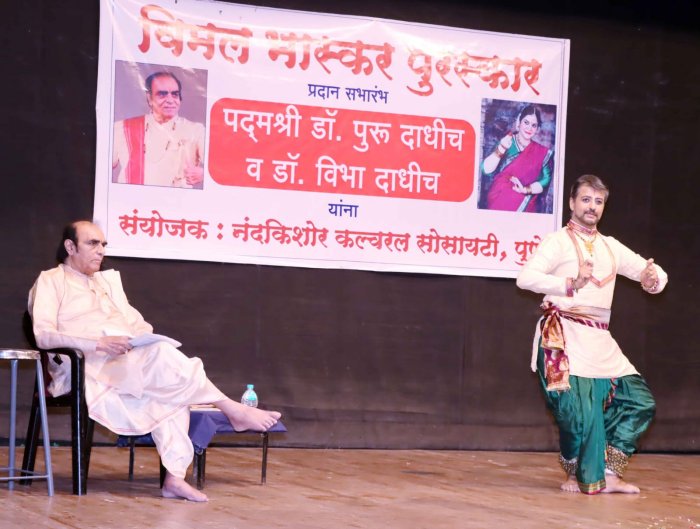 Dr. Piyush Raj demonstrates Ganesh Vandana Photo: Sushil Rathod In Kathak classical dance we see a number of compositions created in the tradition of Pushpanjali. Dr. Dadheech explained that the older treatises such as Kanoon-e-Mausiki and others called this the Pohopajuri. Dr. Dadheech has discovered a number of compositions of Pohopajuri tradition in the Mridang Sagar text by Pt. Ghanshyam Das of Nathdwara. 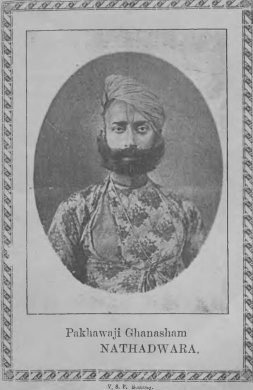 Pt. Ghanshyam Das lists a number of Paran in the Pohopajuri tradition Photo: Tush Dadheech, Natavari Kathak Nritya Academy Archives Dr. Dadheech spoke of the Sudhang movement which is unique to Kathak and not seen in any other dance style. It is linked with the Radha-Krishna legend and is performed in Kathak to this day. Shabd Nritya defined by Sangeet Darpan and Sangeet Maleeka Dr. Puru Dadheech explained that today's Kathak repertoire of Toda, Tukda, Paran, Sangeet ke Tukde etc. have their origins in medieval texts. The phrase Shabd Nritya is used to denote these elements in the writings of Pt. Chatur Damodar's Sangeet Darpan and Muhammad Shah's Sanskrit language work Sangeet Maleeka. Pt. Chatur Damodar was the shastragya at the court of Shahaji Maharaj (father of Shivaji Maharaj), said Dr. Dadheech. 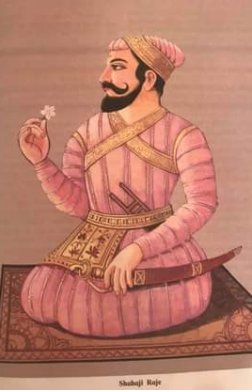 Shabd Nritya was defined by Pt. Chatur Damodar, the shastragya at the court of Shahaji Raje (father of Shivaji Maharaj) Dr. Puru Dadheech uncovered the Kathak dance repertoire and linked it to the dance manuscripts in this way. He willingly shared his life's work, and it was clear that Dr. Dadheech is enthusiastic about Kathak and its treatises, as evidenced by his generous sharing of his results. Based on the literature of Nayak Bhed (Character portrayals and categorization), Dr. Dadheech has composed and set to music Krishna as Dheerlalit and Ram as Dhirodhaatt. At the event, these were beautifully performed by Dr. Piyush Raj and Dr. Sunil Sunkara respectively.  Dr. Sunil Sunkara performing 'Nayak Bhed Dheerodaatt' Photo: Sushil Rathod According to Dr. Puru Dadheech, there is a lot of literature available on Lord Ram; however, it has not been fully utilized in Kathak classical dance. His Dheerodaatt Nayak depiction of Ram is an attempt to portray the rich literature associated with Lord Ram. In his composition, Dr. Dadheech beautifully describes the story of the moments when Ram leaves Ayodhya. He has choreographed how he leaves aside his princely attire and meets with all his family and friends and consoles them. Ram remains composed throughout. Dr. Dadheech states that while the Nayak or hero has been portrayed from the perspective of the Nayika or heroine, not much literature is available on the Nayak's own feelings and emotions. Dr. Dadheech's four-character depictions are a valiant and successful move forward in that direction. Another unique composition of Dr. Puru Dadheech set to music is the 'Kali Stavan'. It is a Dhrupad, written especially for Kathak dancers. 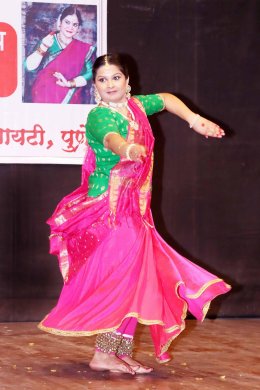 Harshita Sharma Dadheech performing 'Kali Stavan' Photo: Sushil Rathod At the two-day workshop held in Pune, Dr. Puru Dadheech and Dr. Vibha Dadheech showed the depictions of the Nayak Bhed character. They taught Krishna's character Dheerlalit and Ram's character Dheerodaatt. At the workshop, Dr. Puru Dadheech mentioned that Dheerlalit and Dheerodaatt are categorizations of the character of the hero based on behaviour patterns. Dheelalit refers to a self-controlled and light-hearted type of hero who is interested in fine arts and always happy and carefree whilst Dheerodaatt refers to a hero who is passionate and ambitious. Dr. Puru Dadheech wrote the compositions on Krishna and Ram respectively as he believed they brought out the characters of this type of hero. He then set it to music and produced recordings, especially for Kathak practitioners. They also demonstrated a variety of original Jaati compositions. Jaati is the arrangement of bol within the beat of a time cycle. The five Jaati taught at the workshop were Tishra Jaati - Three bols in one beat, Chatushra Jaati - Four bols in one beat, Khanda Jaati - Five bols in one beat, Mishra Jaati - Seven bols in one beat and Sankeerna Jaati – Nine bols in one beat.  Dancers learning Dheerodaatt production from Dr. Vibha Dadheech and Dr. Puru Dadheech at Nandkishore Cultural Society Photo: Tush Dadheech 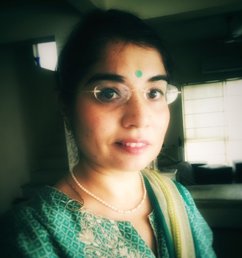 Kiran Java is a writer. She has a Bachelor's degree in Marketing from Eastern Connecticut State University, USA, and is pursuing a Masters degree in Journalism and Communication. She holds a Diploma in Natyashastra with Kathak relevancy under Dr. Puru Dadheech and certification in Vallabh Vedanta from Mumbai University. |